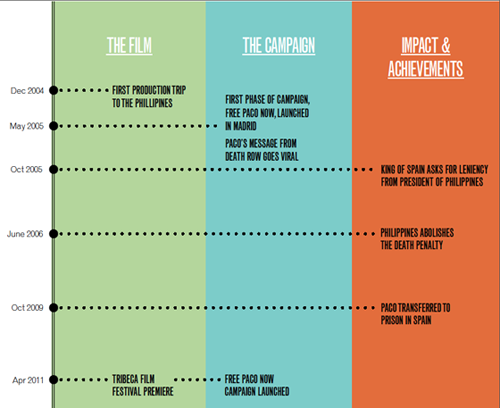
The envelope has been opened: On November 13, in a packed ceremony in New York, the PUMA Impact Awards jury named the controversial and searing Act of Killing this year’s winner. But how did they decide?
For the second year in a row, UK-based documentary foundation BRITDOC shone a light on the selection process by publishing in-depth case studies examining the impact of the five finalists. For example, the report on The Act of Killing observes that the film was seen at 100 festivals in 57 countries, at 1000 community screenings in 118 cities and received 29 awards and prizes. More importantly, the film showed how Indonesian death squad leaders from 1965-6 are still celebrated as heroes, revealing the ways in which this creates a culture of intimidation and impunity. In the process, it created an opening for unprecedented coverage and discussion of the massacres, and informed a national human rights commission. Plus, BRITDOC researchers note, “The Act of Killing is a rare example of a film that both works to expose a political injustice and has also been lauded for its cinematic inventiveness.”
In addition to The Act of Killing, this year’s finalists included Bully, Give up Tomorrow, The Invisible War, and The Interrupters. Combining narrative, data and observations from a committee of peers assembled to judge the films, the reports on these films don’t just provide compelling accounts of makers and advocates working together to make change. They offer a useful framework for other makers and funders seeking to evaluate media impact. Taken as a whole, the case studies also demonstrate the complexities of trying to boil impact down into a simple process or replicable formula.
Both the filmmakers and the advocates they document and engage have spent many years focused on the issues in question. BRITDOC has assembled timelines in each case study, ranging in duration from two to nine years. These track the relationships between key moments in the film’s life—production trips, screenings, festival premieres and airings—with related campaign actions, and relevant impact benchmarks.

BRITDOC set a daunting bar for makers and researchers alike in order to be considered for the award. The wins the filmmakers record are big: both Bully and The Invisible War spurred response from members of Congress and President Obama; The Interrupters led to a million dollar commitment from Chicago mayor Rahm Emanuel for the CeaseFire organization featured in the film; Give Up Tomorrow has eased the prison sentence of subject Paco Larrañaga, and catalyzed death penalty reform in the Philippines, and The Act of Killing has opened up a long-suppressed national debate about why leaders from that era are still in power rather than behind bars.
But, as these reports reveal, these are not simply heroic solo efforts. Collaborating with outreach, digital, organizing and PR experts, the filmmakers tap into complex distribution, grassroots and policy networks in order to amplify their subjects and mobilize stakeholders. Many small triumphs pave the way — new partnerships, notice by key celebrities and media personalities, international broadcasts, and hundreds of screenings where those seeking reform gather in small groups to wrestle with the films’ tough messages. Of course, there are also losses, teachable moments that the researchers are able to capture.
Each case study tracks the outcomes of the campaigns through a series of parallel sections. These reflect the categories used to judge PUMA Impact award-winners, such as:
- What the critics said
- Who saw it: festivals, cinema, TV, DVD, screenings, online
- Campaign aims, and how the campaign worked
- Online trends, with a particular focus on key discussion spikes on Twitter
- Production and campaign budgets
- Campaign partners
- Campaign achievements, including field building, engaging influentials, adoption by educators, political wins, corporate buy-in, positive press response, formation of new organizations and networks, assistance/remedy for victims, and more
- Awards
The bones of these case studies mirror other frameworks that have been developed by the leading documentary analysts we brought together in our recent Media Impact Focus event, such as this heuristic developed by the Fledgling Foundation:

Such frameworks have proven useful to makers and funders for both evaluation and design of high-impact media. But it is the particular details of strategy and persistence, and the moments of sharp insight demonstrated by filmmakers and their allies that make BRITDOC’s reports valuable reading.
A simple structural or quantitative comparison of documentary campaigns misses inspired moments, such as the decision by the Act of Killing producers to selectively geoblock downloads of the film, so that Indonesians could download and screen it in private without the threat of violence that accompanied public screenings. The case studies also capture moments when researchers struggled with questions of causation vs. correlation. For example, what role did The Interrupters play in the 100% reduction in violence in Woodlawn, where CeaseFire operates? It’s hard to say exactly, but it’s an interesting question to ask, and for this emerging field to continue to try to answer.
How can those seeking to understand how media sparks social change strike a useful balance between this degree of specificity and the drive to develop comparative models? We’ll pick that question up in our next post, exploring the Harmony Institute’s Impact Space.
Through December, MIF’s AIM section will be exploring emerging tools for media evaluation. Questions? Contact Jessica Clark.
